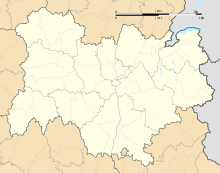Choranche cave
| Choranche cave | |
|---|---|
 Flowstone in Choranche cave. | |
| Location | Choranche, France |
| Coordinates | 45°04′28.6″N 5°23′54.4″E / 45.074611°N 5.398444°E |
| Depth | + 425 metres (1,394 ft) |
| Length | 32,301 metres (105,974 ft) |
| Elevation | 574 metres (1,883 ft) Coufin |
| Geology | Limestone |
The cave of Choranche, also called cave of Coufin-Chevaline, is located in the department of
The entrance to the cave is at the foot of the
.In
History
Coufin Cave
Oscar Decombaz, on 7, explored up to the wet vault. In 1949, the defusing of the latter allowed Roger Pénelon and Sage to access Gruyère. In 1954, the Cyclops group went up the Mat waterfall (+116 m (381 ft))[a] and stops at the foot of the large waterfall.
-
Grottes de Coufin in circa 1924.
Chevaline Cave
In 1943, Roger Pénelon,
Description

Like all
Species conservation
The Choranche cave constitutes one of the two sites in France where resides (in captivity) the olm, species of blind salamander adapted to karstic caves. Originally from the caves of the Dinaric Alps of the western Balkans, this species was brought to Choranche as well as to the Clamouse cave as part of a research and project to protect the species.
Notes
- ^ In caving, the negative or positive measurements of height levels are defined in relation to at a reference point which is the known entrance to the network, the highest in altitude.
References
- ^ "Discover the site". caves-de-choranche.com (in French).[permanent dead link].
- ^ "Choranche". parc-du-Vercors.fr (in French). 19 May 2006. Archived from the original (pdf) on August 1, 2017. Retrieved May 14, 2017..
- ^ "Coranche, high tourist quality". Spot Magazine, Grenoble edition (in French). No. 125. January 2015. p. 4. Archived from the original on 3 March 2016.
- ^ Caillault et al. 1997, pp. 101–105.
- ISSN 0336-0326.
- ISSN 0751-7688. Retrieved May 14, 2017, p. 40.
- ^ Keith Paterson (1974). "Contribution to the study of the underground hydrology of the Presles plateau and the Coulmes massif (Vercors)". Journal of Alpine geography (in French). 49: 241–251. Retrieved 2 December 2021.
Works cited
- Serge Caillault; Dominique Haffner; Thierry Krattinger (April 1997). Spéléo sportive dans le Vercors (in French). Vol. 1. Aix en Provence: Edisud. ISSN 0764-2520.



